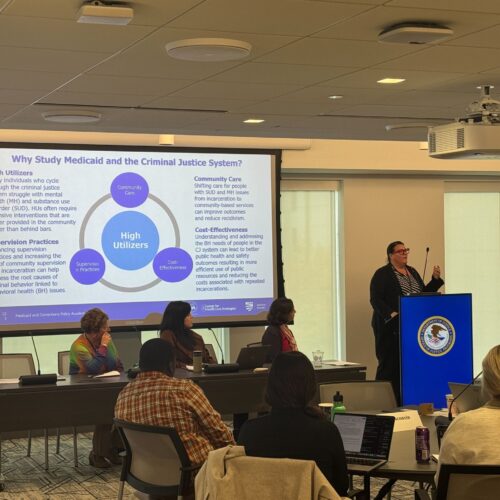Confined and Costly Methodology
To assess the impact of supervision violations on prison admissions and population, The Council of State Governments (CSG) Justice Center obtained data using a combination of publicly available state reports and survey responses provided by state corrections department research staff. In 2018, the CSG Justice Center contacted research directors in all 50 states requesting their participation in a survey.
Survey Design and Definition of Terms
The survey consisted of four parts: (I) project description and definition of terms; (II) admissions data collection; (III) snapshot population data collection; and (IV) capacity for data sharing. In Part I, the following definitions were outlined:
Total Admissions to Prison: the number of people admitted to state-funded incarceration as a result of a sentence to incarceration of any length or a violation of supervision conditions.
- Include people sentenced to a term of incarceration regardless of sentence length (include jail sentences in unified systems). This may include people held in private facilities as well as county-run facilities, provided they have been sentenced or formally sanctioned by a court or supervision authority and their incarceration is state funded.
- Include people incarcerated for short sanctions in state-funded custody (may include county jails) while on probation or parole/post-prison supervision.
- Exclude movements such as transfers, returns from bench warrants, and furloughs.
- Exclude people awaiting trial (i.e., pretrial admissions) or civil commitments.
Admissions to Prison on a Violation of Probation Supervision Conditions: the number of people admitted to state-funded incarceration as a result of a violation of probation supervision conditions.
- Include people admitted on new offense violations as well as technical violations of probation supervision.
- Include people who have violated probation conditions where probation functions as a post-prison supervision term (e.g., split sentence).
- Include people incarcerated for short sanctions in state-funded custody (may include county jails) while on probation supervision.
- Exclude people incarcerated in a county jail or other non-state-funded custody while awaiting a probation revocation hearing.
Admissions to Prison on a Violation of Parole/Post-Prison Supervision Conditions: the number of people admitted to state-funded incarceration as a result of a violation of parole/post-prison supervision conditions.
- Include people admitted on new offense violations as well as technical violations of parole/post-prison supervision.
- Include people incarcerated for short sanctions in state-funded custody (may include county jails) while on parole/post-prison supervision.
- Exclude people who have violated post-prison probation supervision conditions (as they are to be counted in the previous category).
- Exclude people incarcerated in a county jail or other custody that is not state funded while awaiting a parole/post-prison revocation hearing.
There are two important things to note in the definitions used for this report: (1) prison admissions and population include any state-funded incarceration, which may include county jails if the incarceration is funded or reimbursed by the state, and (2) supervision violations include both supervision revocations and incarceration sanctions imposed outside of a revocation. Each of these elements has the potential to greatly impact the rates of supervision violations among prison admissions and population, but the degree to which these practices exist and the degree to which they are or can be captured in data, varies across states. In addition, some states submitted data using definitions that varied due to either technological limitations (i.e., they were unable to provide data based on the given definitions) or to follow the ways in which a state had historically reported this data, which may have differed from the definitions provided. Information on variations from these definitions, as well as whether a state’s data includes county jail admissions or non-revocation incarceration sanctions, is included in the state-specific snapshots.
Parts II and III of the survey consisted of data collection on prison admissions and population using the definitions outlined in Part I, including the following data points:
- Total prison admissions and population
- Prison admissions and population in prison on a violation of probation supervision (including new offense and technical violations)
- Prison admissions and population in prison on a technical violation of probation supervision
- Prison admissions and population in prison on a violation of parole and/or post-prison supervision (including new offense and technical violations)
- Prison admissions and population in prison on a technical violation of parole and/or post-prison supervision
For each data point requested, published data was included if available. Survey respondents were then asked to provide new data or adjustments to the published data collected. Calendar years 2012 to 2017 were requested for each data point. In addition, a series of questions were included to help gain a better understanding of the data submitted (e.g., types of supervision sanctions employed outside of revocation, what constitutes a technical vs. new offense violation) and the challenges, if any, in providing the data.
Part IV of the survey included a question on whether the state would be willing to share case-level data, as necessary, to help fill in gaps in data that the survey was unable to capture. In addition, a series of questions regarding the state’s criminal justice data systems were included to gauge data availability and potential linkages across systems. Although these questions helped provide additional background and context for state data systems, no case-level data was requested or obtained for this project due to the high response rate to the survey.
Data Collected
In total, the CSG Justice Center obtained data from 49 states on at least one of four metrics for 2017: (1) probation violation admissions, (2) parole and/or post-prison violation admissions, (3) probation violation population, and (4) parole and/or post-prison violation population. States that submitted data on probation and parole/post-prison violation admissions and population also provided the total number of prison admissions and/or population for the year. In 46 states, these data were obtained through the survey and in an additional three states—Montana, Nevada, and New Mexico—surveys were not submitted but data were collected from other publicly available sources. Vermont was the only state for which no data were obtained on any of the metrics. Of 49 states with data, probation or parole/post-prison violation admissions were obtained in 48 states (all but Delaware), and in 45 states (all but Connecticut, Maine, New Hampshire, and New Mexico), data were obtained on probation or parole/post-prison violation population. In addition to the four metrics, a subset of states was also able to provide a breakdown of the number of probation and parole/post-prison violation admissions and population that were the result of a technical violation. Appendix A presents a table of the type of data obtained by state.
To calculate the share of prison admissions that were the result of a probation or parole violation, the number of probation and/or parole violation admissions was divided by the total number of prison admissions. For states that also provided the number of admissions that were the result of a technical violation, that number was divided by the total number of prison admissions to find the share of admissions that were due to technical violations of supervision. The same calculation was applied to the population data to find the share of a state’s prison population that was incarcerated because of a probation or parole violation.
Cost Estimates
To produce an estimate of the state costs of incarcerating people for supervision violations, an estimated state prison cost per day was calculated for each state using the total prison population reported through the survey and the total state prison expenditures reported in the Vera Institute of Justice’s The Price of Prisons: Examining State Spending Trends, 2010–2015. In May 2016, Vera distributed a survey to each state’s department of corrections to collect data on state prison expenditures for fiscal years 2000, 2005, 2010, and 2015, and received completed surveys back from 45 states. This information was later published in The Price of Prisons, and the data were made available online. Through the CSG Justice Center survey, 39 states provided the total prison population on a given day in 2018, and eight states provided the population on a given day in 2017 for a total of 47 states with prison population data (all but New Hampshire, New Mexico, and Vermont). These population data were then divided by Vera’s state prison expenditure data for fiscal year 2015, and the total was divided by 365 to produce an estimated per-person cost per day in each state’s prison. A regional average cost per day was used in three states that did not submit prison expenditure data for the Price of Prisons (Mississippi, Nebraska, and Wyoming). To calculate the cost of supervision violations, the state probation and parole/post-prison violation population and technical violation population figures were applied to the per-person cost per day. Estimated costs produced for this report are based on a cost per day that includes the full cost to staff and operate prisons, which exceeds the marginal costs often used by corrections departments for budgetary purposes. Marginal costs, which include food, clothing, and medical supplies, are more directly affected by the number of people incarcerated, whereas full costs include other fixed costs (i.e., staff, building maintenance) that may not be affected by a reduction in the incarcerated population.
| States | Probation violation admissions | Technical probation violation admissions | Parole violation admissions | Technical parole violation admissions | At least one admissions metric | Probation violation population | Technical probation violation population | Parole violation population | Technical parole violation population | At least one population metric |
|---|---|---|---|---|---|---|---|---|---|---|
| Alabama | X | X | X | X | X | X | X | X | X | X |
| Alaska | X | X | X | X | X | X | X | X | X | X |
| Arizona | X | X | X | X | X | X | X | X | X | X |
| Arkansas | X | X | X | X | X | X | X | X | X | |
| California | X | X | X | X | X | X | X | X | X | X |
| Colorado | X | X | X | X | X | X | X | X | X | X |
| Connecticut | X | X | X | X | ||||||
| Delaware | X | X | ||||||||
| Florida | X | X | X | X | X | X | X | X | X | X |
| Georgia | X | X | X | X | X | X | X | X | ||
| Hawaii | X | X | X | X | X | X | X | X | X | X |
| Idaho | X | X | X | X | X | X | X | X | ||
| Illinois | X | X | X | X | X | X | ||||
| Indiana | X | X | X | X | X | X | X | X | X | X |
| Iowa | X | X | X | X | X | X | X | X | X | X |
| Kansas | X | X | X | X | X | X | X | X | X | X |
| Kentucky | X | X | X | X | X | X | X | X | X | X |
| Louisiana | X | X | X | X | X | X | X | X | X | X |
| Maine | X | X | X | |||||||
| Maryland | X | X | X | X | X | |||||
| Massachusetts | X | X | X | X | X | X | X | X | ||
| Michigan | X | X | X | X | X | X | X | |||
| Minnesota | X | X | X | X | X | X | X | X | ||
| Mississippi | X | X | X | X | X | X | X | X | X | X |
| Missouri | X | X | X | X | X | X | X | X | X | X |
| Montana | X | X | X | X | X | X | X | X | X | X |
| Nebraska | X | X | X | X | X | X | X | X | X | |
| Nevada | X | X | X | X | X | X | X | X | X | X |
| New Hampshire | X | X | X | |||||||
| New Jersey | X | X | X | X | X | X | ||||
| New Mexico | X | X | ||||||||
| New York | X | X | X | X | X | X | ||||
| North Carolina | X | X | X | X | X | X | X | X | ||
| North Dakota | X | X | X | X | X | X | X | X | X | X |
| Ohio | X | X | X | X | X | X | X | X | X | X |
| Oklahoma | X | X | X | X | X | X | X | |||
| Oregon | X | X | X | X | X | X | X | X | X | X |
| Pennsylvania | X | X | X | X | X | X | X | |||
| Rhode Island | X | X | X | X | X | X | X | X | X | X |
| South Carolina | X | X | X | X | X | X | X | X | ||
| South Dakota | X | X | X | X | X | X | X | X | X | X |
| Tennessee | X | X | X | X | X | X | X | X | X | X |
| Texas | X | X | X | X | X | X | X | X | X | |
| Utah | X | X | X | X | X | X | X | X | ||
| Vermont | ||||||||||
| Virginia | X | X | X | X | X | X | X | X | X | X |
| Washington | X | X | X | X | X | X | X | X | X | X |
| West Virginia | X | X | X | X | X | X | X | X | ||
| Wisconsin | X | X | X | X | X | X | X | X | X | X |
| Wyoming | X | X | X | X | X | X | X | X | X | X |
| Total number of states | 43 | 36 | 47 | 42 | 48 | 40 | 29 | 42 | 37 | 45 |
A positive school experience, where a child feels secure, is essential for their well-being. However, for many children…
Read MoreWhen returning to their communities from criminal justice settings, people with behavioral health needs face barriers in accessing…
Read More Supporting Children of Incarcerated Parents: Reimagining School and Community Collaboration
Supporting Children of Incarcerated Parents: Reimagining School and Community Collaboration
A positive school experience, where a child feels secure, is essential for their well-being. However, for many children with incarcerated parents—one in 14 in the U.S.—school can feel far from safe due to stigma, trauma, and a lack of understanding.
Read More Assigned to the Cloud Crew: The National Incarceration Association’s Hybrid Case Management for People with Behavioral Health Needs
Assigned to the Cloud Crew: The National Incarceration Association’s Hybrid Case Management for People with Behavioral Health Needs
When returning to their communities from criminal justice settings, people with behavioral health needs face barriers in accessing basic needs—including food, housing, employment, transportation, education, clothing, and substance use and mental health services—which increases their risk of experiencing a crisis.
Read More Meet the Medicaid and Corrections Policy Academy Mentor States
Meet the Medicaid and Corrections Policy Academy Mentor States
New Hampshire Department of Corrections Commissioner Helen Hanks presents at the Medicaid and Corrections Policy Academy in-person meeting.
Read More Taking the HEAT Out of Campus Crises: A Proactive Approach to College Safety
Taking the HEAT Out of Campus Crises: A Proactive Approach to College Safety
The sharp rise in school shootings over the past 25 years has led school officials across the U.S. to take a closer look at ways to keep students safe. For Chaffey College in Rancho Cucamonga, California, a tragic incident at a nearby university hit close to home and spurred campus leaders to revisit their own school’s threat assessments and crisis responses.
Read More New Smart Supervision Resident Analyst Program to Increase Supervision Agencies’ Data Analysis Capacity
New Smart Supervision Resident Analyst Program to Increase Supervision Agencies’ Data Analysis Capacity
Ideally, leaders would have actionable data readily available to them when they need it most. However, many agencies encounter significant challenges related to procuring accurate, consistent, and timely data, often grappling with outdated systems and inadequate tools.
Read More










